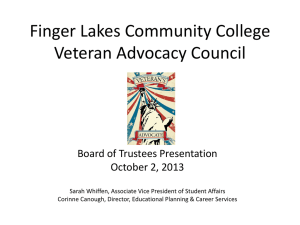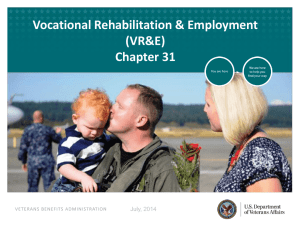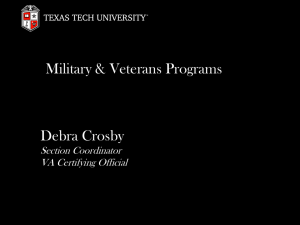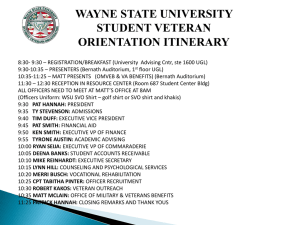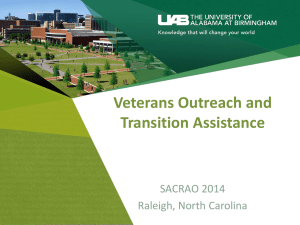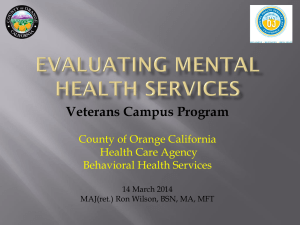student veteran - Innovative Educators
advertisement
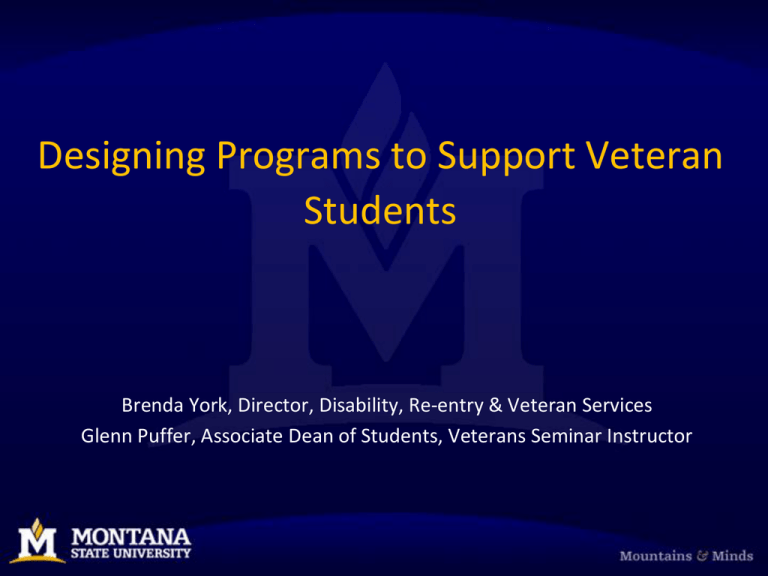
Designing Programs to Support Veteran Students Brenda York, Director, Disability, Re-entry & Veteran Services Glenn Puffer, Associate Dean of Students, Veterans Seminar Instructor Unique Needs for Veterans • Almost all Iraq/Afghanistan veterans have been shot at, attacked or ambushed. • PTSD, major depression, and anxiety are estimated to affect one in six veterans. • Mild and moderate TBI is the “signature injury” of these conflicts. • Hearing loss in returning veterans is becoming an increasing issue. • Readjustment issues often surface six to twelve months after returning. On Campus • Educational bureaucracy, financial aid, VA benefit applications can be difficult. • Veterans may attempt too many credits to make up for lost time. • They are often reluctant to ask for help or to take advantage of counseling services. • Cannot relate to their peers in classrooms. • Frustration or anger at professors and students who vocalize anti-war sentiment Why the need to know • The new Post 9/11 GI Bill will and is changing the face of campuses; • The new GI Bill will have the same effect that the original GI Bill post World War II had; • Many vets are returning with mental and physical disabilities or a combination of both; • Vets that would not have attended college prior to the new Post 9/11 GI Bill now will; • Colleges need to be ready, especially disability offices, housing, counseling, Dean of Students, and other support areas. • Academic areas will also be impacted. The New Post 9/11 GI Bill • The Post 9/11 GI Bill was passed in 2008 and implementation began August 01, 2009. • Any soldier that has active duty time can be eligible for the Post 9/11 GI Bill. • Active duty time equals percentage eligible for the GI Bill. • Tuition and fees are paid at the eligibility rate. Example 36 months of active duty service=100% • The veteran also receives a housing allowance and book stipend. GI Bill continued • Veteran benefits are no longer considered resources for financial aid purposes, as of July 01, 2009 • The Post 9/11 GI Bill allows for transferability to dependents of veterans depending on Dept. of Defense eligibility requirements. • Schools may voluntarily enter into the Yellow Ribbon program with the VA to waive or match unmet need • In a “nutshell” this new GI Bill will increase the number of veterans returning to school and increase the need of services for the veteran. CHAT TIME Misconceptions • Not all veterans have been in combat; • Not all have served in Iraq/Afghanistan; • And finally, not all have PTSD. Education/Information for Faculty and Staff • It is important for all faculty and staff to know who the veteran coordinator or certifying official is on your campus. • Set up an informational session at department meetings to discuss veteran issues/needs. • Be on campus committees to represent veterans on your campus. Veteran Information Fairs • Check with your local Veteran Service Office (VSO) to see if any reintegration events are happening. • On your campus have a veteran information session and have academic and support services there to supply what services are offered. Veteran Orientation • First year was Summer 2009 • Hoped to have 15-20 sign up…had 41 attend. • One day session, right before school started for fall. • I registered them early with the mandate they attend the orientation, all but 3 did. Orientation continued… • Needs to be coordinated with your orientation office for: •Publicity •Coding in your campus system •General information for walk-ins, phone calls, etc. •Campus tours •General support Orientation continued • Plan to start early and finish early • We offered the vet orientation from 7:30 AM 2:30PM • Provided breakfast and lunch • Local vendors donated drinks through out the day Orientation agenda • • 7:30 AM: 7:50 AM: Breakfast Buffet Introductions • Welcome-Vice President of Student Affairs • • • • • • • • • • • • 8:00 AM: 8:15 AM: 9:30 AM: 9:45 AM: 10:15 AM: 10:45 AM: 11:15 AM: 12:15 PM: 1:15 PM: 2:15 PM: 2:30 PM: 2:45 PM: GI Bill QuestionsAdvising Information- University Studies & Registration InfoBreak Financial AidCareer Services Health Services Counseling and Psychological Services Lunch DOS/FYI/CSI Resources in the community for vets Questions Campus Tour Agenda…did it work? • Presenters were very excited to discuss procedures & policies with veterans • There was very good interaction between vets and presenters • Time given seemed to be enough • Positive comments, overall Follow UP • Veterans that attended the orientation had a successful semester. One dropped out of school by week 2 but all others had a productive fall semester. • We deal with over 350 veterans, the orientation “cohort” were the ones that followed registration time lines, student account deadlines, etc • Were able to use that cohort to work with a dedicated Veteran First Year Initiative mentor for follow up on study skills, time management, test taking, etc… Changes • Add someone from student accounts to speak • Allow more time at end for questions • Do a vet fair in another room or back of room for all the off campus resources-we had numerous calls and not enough time for them all Changes…. • Discussion about later in day so families can come in evening? • Discussion meeting will happen mid spring to discuss the next orientation • Have a spring semester “mini-orientation”? Chat time Designing Programs to Support Veteran Students: First Year Experience and Institutional Policies MSU First Year Experience • MSU Fridays (campus visits) • Orientation – College Student Inventory – College Expectations • University Convocation (summer reading) • First Year Seminar • WRIT 101 (Core writing component) First Year Seminar • “”…an introduction to college studies aimed at expanding students’ intellectual interests, improving critical thinking and communication skills, and creating a community of learners” (Core 2.0) • Required of all first year students Seminar Goals • Provide educational setting to share process of intellectual inquiry • Provide opportunities to speak effectively about ideas, interpretations, insights, goals • Provide supportive instruction and practice in essential research and writing skills • Foster individual initiative, responsibility, intellectual rigor, lifelong learning Seminar Components • • • • Critical reading (texts, selected topics) Student-led class discussions Oral presentations Academic writing – curriculum prescribed – instructor assigned – objective/analytical/researched • On/Off-campus lectures and events Veterans Seminar Section • A student veteran initiative • Cooperation/collaboration among Veterans, Veterans’ Services and University College (First Year Seminar) – Preferential (elective) enrollment – Credible (prior military?) instructor – Contingent on adequate subscription – Curriculum “tailored” to Veterans Obstacles/Concerns • Originally not well received by colleges – Objections to lack of diversity – Funding for undersubscribed section – Concern for adequate instructional expertise – Concern for Peer Leader selection – Concern for control of “tailored” curriculum – Concern for assurance of academic rigor Obstacle Resolution • • • • University College sponsors test section Veterans Services shares funding Faculty (Retired Army LTC) instructor Student veteran who proposed seminar, completed course 2005, as Peer Leader • Teach curriculum “as is” for test Veterans Seminar Fall 2006 • Class size 13 (2 non-Vet ) • Entering class standing – 10(true) Frosh, 2 Junior, 1 Senior • Age: Range 19-37, Mean 23.5 • Gender: 3 Female, 10 Male • Deployed: 4 • Persistence: 10/13, 77% (Vet 8/11, 73%) Veterans Seminar Fall 2007 • Class size: 8 (all Vet) • Entering class standing – 5(true) Frosh, 2 Sophomore, 1 Senior • Age: Range 23-29, Mean 24.8 • Gender: 1 Female, 7 Male • Deployed: 6 • Persistence: 6/8, 75% Veterans Seminar Fall 2008 • Class size: 16 (11 non-Vet) • Entering class standing – 13 (true) Frosh, 3 Sophomore • Age: Range 18-40, Mean 23.7 • Gender: 7 Female, 9 Male • Deployed: 4 • Persistence: 12/16, 75% (Vet 3/4, 75%) Veterans Seminar Fall 2009 • Class size 17 (all Vet) • Entering class standing – 13(true) Frosh, 2 Junior, 1 Senior • Age: Range 19-36, Mean 26.4 • Gender: 2 Female, 15 Male • Deployed: 13 (multiple deployments 5) • Persistence: 17/17, 100% (Spring 2010) Observations Over 4 Iterations • Veterans self-select in/out of section – Don’t want to be “special” – Don’t want to continue military association – Concern for treatment as “different” in class – Alienated from traditional undergrad pop – Do seek to learn/socialize with other Vets – Are looking for administrative/academic support from those “in the know” Observations Over 4 Iterations • A Veterans section encourages greater class participation, sharing of ideas, candid communication among peers (camaraderie) • Veterans are generally less well prepared academically, either due to lengthy absence from the academic environment or under-performance in secondary education Observations Over 4 Iterations • While vocal on current events, academic assignments that focus on military subjects are not well received (ex:“War is a Force That Gives Us Meaning,” 2007) • Writing/speaking assignments that demand use of multiple research tools are effective in improving critical academic performance Observations Over 4 Iterations • Veterans expect clear, concise instructions and assignments with well defined expectations: “What do you want, and when do you want it?” The instructor’s challenge is to encourage analysis and synthesis of information, not just “garbage in, garbage out.” • Immediate feedback is important. Veterans are by training results/outcomes oriented. Observations Over 4 Iterations • Short (1-3 pages) writing assignments are most productive for improving writing skills. Relate to the military acronym “C3I” (Command, Control, Communications & Intelligence) • Replace with “Clear, Concise, Complete & Informative” • “Weekly Quote.” One page exercise: (1) quote (2) context (3) significance Observations Over 4 Iterations • Group Assignments are effective learning tools – Veterans are familiar with “Collective” training – One group member will take charge, all other members will support (collegial activity) – “Modified Oxford Debate” of student-selected topics was especially popular, fostered close teamwork and detailed research of both sides of subject. • Students appreciate external “expert” instruction and evaluation (guest instructors) CHAT TIME College Student Inventory* (CSI) • The College Student Inventory (CSI) is a self-assessment tool designed for first-year students that asks students to reflect on their personal, social, and academic adjustment to college. The online survey is comprised of approximately 100 questions, and is organized under three main areas: • Academic Motivation • General Coping Skills • Receptivity to Support Services *Noel-Levitz College Student Inventory (CSI) The CSI serves to: • Assess the individual academic and personal needs of students • Recognize strengths and coping strategies • Identify students who are at risk for academic and/or personal difficulties • Provide information about student needs for the development of programs and services • Understand the attitude and motivational patterns of new students • Help advisors and instructors establish effective contact with students early on Veterans Indications from the CSI • Academic Motivation (Inside the classroom) – – – – – Math & Science confidence: Low (-8 pts ) Study Habits: High (+12 pts) Intellectual Interest: High (+6 pts) Attitude Toward Educators: Average (-1pt) Desire to Finish College: High (+7pts) • Women over 30 pts higher than Frosh cohort • Men over 4 pts higher Veterans Indications from the CSI • General Coping Scales (outside the classroom) – Sociability: Low (-10 pts) “I’m not here to major in friends” – Career Closure: High (+30 pts) • Receptivity Scales (general) – Academic Assistance: High (+11 pts) – Personal Counseling: Low (-15 pts) – Career Counseling: Low (-25 Pts) Conclusions(?) from the CSI • Veterans are here for a purpose • Veterans are open to seeking assistance (they know enough to know they don’t know enough) • Veterans tend to decide on college late • Veterans are career-minded • Veterans are resistant to obstacles • Veterans are sensitive to environment Institutional Policies • Implement policies that accommodate students who are deployed mid-term, or return late from deployment – Assist with grades, exams, incompletes – Rescind registration, no W grades – No financial penalties – Register in absentia, waive/defer advising – Coordinate with instructors CHAT TIME Best Practices • Changes in institutional financial policies: flexible payment policies with payments deferred until benefits begin. • Ensure access to counseling and therapy groups on campus. • Provide a space on campus where veterans can relax and hang out together. Staff it with a work-study student veteran. • Assist students with filling out complex paperwork. • Train academic advisors in veteran needs and issues. • Offer training to faculty about sensitivity in political discussions. • Try to enlist full support for veterans’ programs from the top on down. Best Practices… • Learn about veteran resources in your community. • We started a veteran advisory committee about 5 years ago and it has grown. – Veteran Service office – Job Service – Mental Health – Local veteran groups – Senator reps Summary • First and foremost…collaborate, collaborate, collaborate! • Think outside of the box • Many veterans are very independent and will not seek help • As one vet told me he really hates doctors, staff, etc. that talk to him like a 2 year old…he has probably seen more than many will have in a lifetime Thanks!!! • Questions? Resources • • • • • • http://www.rand.org/multi/military/ http://www.ptsd.va.gov/ http://www.gibill.va.gov/ http://www.woundedwarriorresourcecenter.com/ http://www.publichealth.va.gov/womenshealth/ https://www.noellevitz.com/Our+Services/Retention/Tool s/Retention+Mgmt+System/

